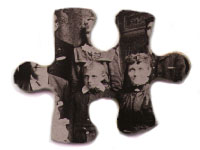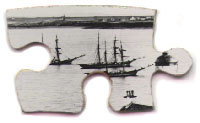



Caithness Archives

An
Extraordinary Son of Caithness
The Story
As dawn broke on November 16,1857, the band of British men and women besieged in the Lucknow Residency prepared themselves for another day of desperate resistance to the murderous intentions of an army of rebel Indian soldiers, or Sepoys as they were known. The Indian Mutiny was at the height of its ghastly glory, and every day the Lucknow defenders expected to be their last. Then, as if in a dream, they heard the skirl of the bagpipes; bayonets glittered in the sun; colours were seen waving in the morning sky and, on a tide of fighting, the kilted warriors of the Highland Brigade could be seen approaching the Residency. Salvation was at hand.
The key to the rebel positions at Lucknow was the Secundrabagh, a fortified stronghold garrisoned by up to 2000 Sepoys. Anyone seriously intending to take and then hold Lucknow clearly had to occupy the Secundrabagh. At the forefront of the assault on this formidable stronghold were the 93rd, Sutherland Highlanders, under the command of the veteran general Sir Colin Campbell.
The fighting at the Secundrabagh was among the bloodiest of this bloody war. On one side was a relief column which had fought its way across a country stained with blood from some of the worst atrocities ever perpetrated against British men, women and children; on the other, a rebel army well trained in the fighting methods of their former masters, and acutely conscious of the fate that awaited them should they be defeated. a burning thirst for vengeance, and the fear of that vengeance: it was a potent fighting mixture.
A desperate struggle ensued, much of it hand-to-hand, swords against bayonets in confined spaces from which it was impossible either to advance or retreat asve over the bodies of one's enemies. In such a horrific environment men performed deeds of heroism far beyond their normal abilities. But, at last, the Highlanders prevailed; the Secundrabagh was in their hands and all its Sepoy defenders were dead.
Six Victoria Crosses were awarded to the 93rd as a result of this morning's fighting at Lucknow. One of them, for capturing a rebel colour, was gained by private David Mackay, a Caithness man.
The story of David Mackay - from his birth in 1831 on a croft at Alterwall, Lyth, to his enlistment in the 93rd, his service with the regiment in the Crimea and in India, his gallantry at Lucknow, the severe wound he sustained just after the Secundrabagh action, his return to England where the Victoria Cross was pinned on his breast by the Queen herself, his subsequent duties as a recruiting sergeant in Aberdeenshire, where he married a local girl, and finally his discharge from the Army and removal to Lesmahagow, where, dying at the early age of 48, he was buried in a pauper's grave - was related by Major Angus Mackay during his recent talk at the Redwood function suite, given on behalf of Thurso Museum.
Among the audience were several descendants of david Mackay, including one from America and another from Lancashire.
However, the origin of the talk was in 1989, when an article by Robert Gunn appeared in the John O'Groat Journal. This article drew largely on the research of the late George Sinclair of Halkirk, who had spent a great deal of time investigating the life of David Mackay, who at that time was a name hardly known in his native county.
Earlier this year, due to information recieved as a result of an article relating to Caithness military history, again in the Groat, Thurso Museum revived the story of David Mackay. David Bews, a local military history enthusiast, was a prime mover in the museum's attempts to collate all the existing information on David Mackay, but thanks is also due to Neville Thomson, of Lancashire, Robert Gunn of Wick, the descendants of the hero currently living in Caithness, and also to Major Mackay for presenting the information in such an interesting manner.
David Mackay's grave is unmarked, he has no memorial in his native county. However, it is hoped that these two anomolies will be set to rights in the near future, and suitable memorials to this brave son of Caithness will be installed both in Lesmahagow and here in Caithness.
Steven Cashmore 1998
Published
in the John O'Groat Journal.
and reproduced with their kind permission.
Post note: Pte David MacKay VC. now has plaque dedicated to him in the Thurso British Legion, donated by the Co-oP Nov 1996.
![]()
Information contained on this page may only be used for
personal use,any request for full or part publication must be
carried out through the Highland archive.
Send information for these archives to william@caithnessarchives.org.uk